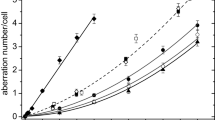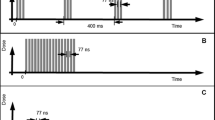Abstract
The effects of single pulses and multiple pulses of 7 MV electrons on micronuclei (MN) induction in cytokinesis-blocked human peripheral blood lymphocytes (PBLs) were investigated over a wide range of dose rates per pulse (instantaneous dose rate). PBLs were exposed to graded doses of 2, 3, 4, 6, and 8 Gy of single electron pulses of varying pulse widths at different dose rates per pulse, ranging from 1 × 106 Gy s−1 to 3.2 × 108 Gy s−1. Different dose rates per pulse were achieved by changing the dose per electron pulse by adjusting the beam current and pulse width. MN yields per unit absorbed dose after irradiation with single electron pulses were compared with those of multiple pulses of electrons. A significant decrease in the MN yield with increasing dose rates per pulse was observed, when dose was delivered by a single electron pulse. However, no reduction in the MN yield was observed when dose was delivered by multiple pulses of electrons. The decrease in the yield at high dose rates per pulse suggests possible radical recombination, which leads to decreased biological damage. Cellular response to the presence of very large numbers of chromosomal breaks may also alter the damage.




Similar content being viewed by others

References
Alpen EL (1998) Radiation biophysics, 2nd edn. Academic press, Tokyo
Alper T (1979) Cellular biology. Cambridge University Press, London, pp 97–100
Averbeck D, Ebert MA (1973) Changed dose-response in Saccharomyces at dose rates above 107 rad per sec. Int J Radiat Res 23:151–156
Bauchinger M, Schmid E, Dresp J (1979) Calculation of the dose-rate dependence of the dicentric yield after Co y-irradiation of human lymphocytes. Int J Radiat Biol 35:229–233
Berry RJ, Hall EJ, Forster DW, Storr TH, Goodman MJ (1969) Survival of mammalian cells exposed to X-rays at ultra high dose rates. Br J Radiol 42:102–107
Bewes JM, Suchowerska N, Jackson M, Zhang M, McKenzie DR (2008) The radiobiological effect of intra-fraction dose-rate modulation in intensity modulated radiation therapy (IMRT). Phys Med Biol 53:3567–3578
Bhat NN, Rao BS (2003) Dose rate effect on micronucleus induction in cytokinesis blocked human peripheral blood lymphocytes. Radiat Prot Dosi 106:45–52
Bhat NN, Acharya Santhosh, Anjaria KB, Sreedevi B (2008) Modification of chromosomal aberrations by high dose rate pulsed irradiation (Abstract). Indian J Radiat Res 5:103
Brahme A (1982) Physical and biologic aspects on the optimum choice of radiation modality. Acta Oncol 21:469–479
Brenner DJ, Hlatky LR, Hanhfeldt PJ, Huang Y, Sachs RK (1998) The linear-quadratic model and most of other common radiobiological models result in similar predictions of time–dose relationships. Radiat Res 150:83–91
Buxton GV, Stuart CR (1995) Reevaluation of the thiocyanate dosimeter for pulse radiolysis. J Chem Soc Faraday Trans 9:279–281
Dao-jun S, Li-fang WU, Li-jun WU, Zeng-hang YU (2001) Dose effects of ion beam exposure on deinococcus radiodurans: Survival and dose response. Plasma Sci Tech 3:665–672
Epp ER, Weiss H, Djordjevic B, Santomasso A (1972) Radiosensitivity of cultured mammalian cells exposed to single high intensity pulses of electrons in various concentrations of oxygen. Radiat Res 52:324–332
Epp ER, Weiss H, Ling CC (1976) Irradiation of cells by single and double pulses of high intensity radiation: oxygen sensitization and diffusion kinetics. In: Ebert M, Howard A (ed) Current topics in radiation research, vol 11. Amsterdam, North Holland, pp 201–250
Fenech M (2000) The in vitro micronucleus technique. Mutat Res 455:81–95
Fenech M, Morley AA (1985) Measurement of micronuclei in lymphocytes. Mutat Res 147:29–36
Fenech M, Morley AA (1986) Cytokinesis block micronucleus method in human lymphocytes; effect of in vivo ageing and low dose X- irradiation. Mutat Res 161:193–198
Fielden EM (1982) Chemical dosimetry of pulses electron and x-ray source in the 1–20 MeV range. In: Baxendale JH, Busi F (eds) The study of fast processes and transient species by electron pulse radioylsis. Dordrecht, Holland, pp 49–91
Frankenberg D (1979) Reparable and irreparable damage in yeast cells induced by sparsely ionizing radiation. Int J Radiat Biol 36:317–324
Gerweck LE, Epp ER, Michaels HB, Ling CC, Peterson EC (1979) Repair of sub lethal damage in mammalian cells irradiated at ultra high dose rates. Radiat Res 77:156–169
Hall J (1971) Radiation dose rate: a factor of importance in radiobiology and radiotherapy. Br J Radiol 45:81–97
Heddle JAA (1973) Rapid in vivo test for chromosomal damage. Mutat Res 18:187–190
Hill MA, Stevens DL, Marsden SJ, Allott R, Turcu ICE, Goodhead DT (2002) Is the increased relative biological effectiveness of high LET particles due to spatial or temporal effects? Characterization and OER in V79–4 cells. Phys Med Biol 47:3543–3555
Hornsey S (1970) Differences in survival of jejunal crypt cells after radiation delivered at different dose rates. Br J Radiol 43:802–806
IAEA (2001) Cytogenetic analysis for radiation dose assessment. A manual. Tech. Rep. 405, International Atomic Energy Agency
Joksic G, Nikolic M, Spasojevic-Tisma V (1997) Radio-sensitivity of different aged human lymphocytes following electron irradiation in vitro. Neoplasma 44:117–121
Kapoor S, Mukherjee T, Kagiya VT, Nair CKK (2002) Redox reactions of tocopherol monoglucoside in aqueous solutions: a pulse radiolysis study. J Radiat Res 43:99–106
Kormos C, Koteles GJ (1988) Micronuclei in x-irradiated human lymphocytes. Mutat Res 199:31–35
Linda CD, Douglas WP, Alan H, Tim W, Wendland B, Frank HJ (2006) Accelerator based radiation sources for next generation radiobiological research. Nuc Inst Methods Phy Res A 562:981–984
Littlefield LG, Sayer AM, Frome EL (1989) Comparisons of dose response parameters for radiation induced acentric fragments and micronuclei observed in cytokinesis arrested lymphocytes. Mutagenesis 4:265–270
Michaels HB, Epp ER, Ling CC, Peterson EC (1978) Oxygen sensitization of CHO cells at ultra-high dose rates: prelude to oxygen diffusion studies. Radiat Res 76:510–521
Mukherjee T (1997) In atomic molecular and cluster physics. In: Ahmad S (ed) Narosa, New Delhi, pp 299–316
Nias AHW, Swallow AJ, Keene JP, Hodgson BW (1970) Survival of HeLa cells from 10 nano-second pulses of electrons. Int J Radiat Biol 17:595–598
Papworth DG (1970) Appendix to paper by Savage JRK sites of radiation induced chromosome exchanges. Curr Top Radiat Res 6:129–194
Prempree T, Michelsen A, Merz T (1969) The repair time of chromosome breaks induced by pulsed X-rays of ultra high dose rate. Int J Radiat Biol 15:571–574
Price KM, Davies S, Michael B (1993) Evidence for induction of DNA double strand breaks at paired radical sites. Radiat Res 134:102–106
Prise KM, Davies S, Michael BN (1992) A comparison of the chemical repair rates of free radical precursors of DNA damage and cell killing in Chinese hamster V79 cells. Int J Radiat Biol 61:721–728
Prosser JS, Moquet JE, Lloyd DC, Edwards AA (1988) Radiation induction of micronuclei in human lymphocytes. Mutat Res 199:37–45
Purrott RJ, Reeder EJ, Lovell S (1977) Chromosome aberration yields induced in human lymphocytes by 15 MeV electrons given at a conventional dose-rate and in microsecond pulses. Int J Radiat Biol 31:251–256
Randy CD, Unklesbay K, Unklesbay N, Clevenger ET, Brazos JB, Mesyats G, Filatov A (2000) Effect of high-dose-rate X-rays on E. coli O157:H7 in ground beef. IEEE Trans Plasma Sci 28:122–127
Roots R, Okada S (1975) Estimation of life times and diffusion distances of radicals involved in X-ray induced DNA strand breaks or killing of mammalian cells. Radiat Res 64:306–320
Santhosh A, Ganesh S, Bhat NN, Siddappa K, Narayana Y (2009) The effect of electron and gamma irradiation on the induction of micronuclei in cytokinesis-blocked human blood lymphocytes. Radiat Environ Biophys 48:197–203
Schulz RJ, Nath R, Testa JR (1978) The effects of ultra-high dose rates on survival and sublethal repair in Chinese-hamster cells. Int J Radiat Biol 33:18–88
Scotl SL, Chen WL, Espenson JH (1993) Spectroscopic parameters, electrode potentials, acid ionisation constants and electron exchange rates of the 2, 2′- azinobis (3-ethylbenzothiazoline-6-sulfnic acid) radicals and ions. J Phys Chem 97:6710–6714
Shinohara K, Nakano H, Miyazaki N, Tago M, Kodama R (2004) Effects of single pulse (< 1 ps) X-rays from Laser-produced plasmas on mammalian cells. J Radiat Res 45:509–514
Smith KJS, Dolphin GW (1958) Chromosome breakage at high radiation dose rates. Nature 182:270–271
Solomon FDP, Venkatachalam P, Jeevanram RK (1997) Analysis of radiation dose response curve obtained with cytokinesis block micronucleus assay. Nuc Med Biol 24:413–416
Sreedevi B, Bharathi B (1989) Studies of radiation induced micronuclei—A rapid method for screening suspected over exposed individuals. Bull Radiat Prot 12:86–90
Tillman C, Grafstrom G, Jonsson AC, Jonsson BA, Mercer I, Mattsson S, Strand SE, Svanberg S (1999) Survival of mammalian cells exposed to ultrahigh dose rates from a laser-produced plasma X-ray source. Radiology 213:860–865
Town CD (1967) Effects of high dose rates on survival of mammalian cells. Nature 215:847–848
Tsyb S, Sokolov VA, Obaturov GM, Makarov GF, Perevozchikova NV (1998) Biological effectiveness of pulsed neutron radiation acting on microorganism cells, Medical Radiological Science Center of the Russian Academy of Medical Sciences. Transl Atomnaya Energiya 85:393–395
Vral A, Thierens H, de Ridder L (1997) In vitro micronucleus-centromere assay to detect radiation damage induced by low doses in human lymphocytes. Int J Radiat Biol 71:61–68
Acknowledgments
The authors gratefully acknowledge the Radiation and Photochemistry Division, BARC, Mumbai, not only for allowing us the use of electron accelerator Linac, but also for assisting with the beam characterization, dosimeter, and sample irradiation. Special thanks go to Nadkarni SA and his colleagues in this regard. The authors gratefully acknowledge the help and useful suggestions of Dr B S Rao, Former Head, Radiological Physics and Advisory Division (RP&AD), BARC, Mumbai. The authors are grateful to research colleagues and technical staff at Microtron Centre, Mangalore University (MU) and RP&AD, BARC, for their help during the course of work. The authors thank Mr Udaya Shetty, Department of Statistics, MU, for the statistical analysis. One of the authors (SA) is grateful to the Board of Research in Nuclear Sciences, Department of Atomic Energy, Government of India for financial support.
Author information
Authors and Affiliations
Corresponding author
Rights and permissions
About this article
Cite this article
Acharya, S., Bhat, N.N., Joseph, P. et al. Dose rate effect on micronuclei induction in human blood lymphocytes exposed to single pulse and multiple pulses of electrons. Radiat Environ Biophys 50, 253–263 (2011). https://doi.org/10.1007/s00411-011-0353-1
Received:
Accepted:
Published:
Issue Date:
DOI: https://doi.org/10.1007/s00411-011-0353-1



